If you saw the insect pests from this list and had to pick out the bed bug, would you be able to do so? Probably is more difficult than you thought. If you’re confused as to which one is a bed bug you’re not alone in this thinking.
At the University of Kentucky researchers found that more than 2/3 of U.S. citizens could not identify a bed bug if they saw one isolated from other types of pests. So, now we know that most people cannot identify a bed bug, let’s take a look at the following and some images to help us identify.
 Flea
Flea
- Identify: Fleas are reddish-brown, similar to bed bugs in color but smaller in size. The appear to be oval in shape. Fleas also have a higher vertical profile and can jump a distance.
- What they Eat: While both feed on blood, fleas prefer hairy animals which help them hide so you will be more likely to see them on your pets, their surrounding area like pet bedding area and on wild animals.
Tick
 Identify: Ticks are in various colors and sizes, but most are brown. Before feeding, they appear flat like bed bugs and have a similar, round body shape. Ticks have eight legs (they belong to the arachnid family) rather than six like the bed bug.
Identify: Ticks are in various colors and sizes, but most are brown. Before feeding, they appear flat like bed bugs and have a similar, round body shape. Ticks have eight legs (they belong to the arachnid family) rather than six like the bed bug.- What they Eat: Ticks can bite humans but they prefer animal hosts. They can jump but usually are found on tall grasses and plants and then drop onto the host. Ticks burrow into the host with their head to feed and can transmit disease while bed bugs are not known to carry diseases and do not burrow into the host.
Swallow Bugs
 Identify: Swallow bugs are approximately the same color and size as a bed bug but are covered in longer hair.
Identify: Swallow bugs are approximately the same color and size as a bed bug but are covered in longer hair.- What they Eat: The primary hosts for swallow bugs are hole-nesting birds, such as swallows; generally closely associated on cliff swallows, but more recently reported on barn swallows and purple martins. Adults and nymphs may come indoors in large numbers in response to the removal of nearby bird nests. They may feed on human blood if their normal hosts are absent.
Carpet Beetle Adults
 Identify: Carpet beetle adults can appear small and round like bed bugs, but they are actually smaller (no larger than 1/7 of an inch) and vary in color—some are patterned with black, white and yellow. Another important difference is carpet beetles have wings and can fly, while bed bugs cannot.
Identify: Carpet beetle adults can appear small and round like bed bugs, but they are actually smaller (no larger than 1/7 of an inch) and vary in color—some are patterned with black, white and yellow. Another important difference is carpet beetles have wings and can fly, while bed bugs cannot.- What they Eat: Carpet beetles feed on pollen and nectar, but can also feed on the cast skins of bed bugs, which can cause confusion when they are seen in the same area as bed bugs. They do not bite humans, but you can get a rash if exposed to the prickly hairs on their bodies.
Cockroach Nymph
 Identify: Cockroach nymphs are white upon hatching, but quickly turn a reddish-brown similar to bed bugs. They have more of a cylinder shape than bed bugs.
Identify: Cockroach nymphs are white upon hatching, but quickly turn a reddish-brown similar to bed bugs. They have more of a cylinder shape than bed bugs.- What they Eat: Cockroach nymphs do not feed on blood. They will eat nearly everything but are not active host feeders like bed bugs.
Bat Bug
 Identify: Bat bugs are blood-sucking insects that feed mostly on bats hence the name. Bat bugs are closely related to bed bugs, and are so similar in appearance that they are often mistaken for bed bugs. Microscopic examination is needed to distinguish them.
Identify: Bat bugs are blood-sucking insects that feed mostly on bats hence the name. Bat bugs are closely related to bed bugs, and are so similar in appearance that they are often mistaken for bed bugs. Microscopic examination is needed to distinguish them.- What they Eat: Bat bugs will also bite humans if given the opportunity. They are more common in the Midwestern states. Fringe hairs are the most common way to tell them apart from the bed bug.
Since it can be easy to mistake bed bugs for other pests, it’s best to have a pest management professional complete an inspection and identify the pest. Correct identification is critical because pests often require different control methods, and when a pest issue is misdiagnosed, the problem may grow and become more severe without proper treatment.

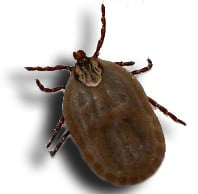 Identify: Ticks are in various colors and sizes, but most are brown. Before feeding, they appear flat like bed bugs and have a similar, round body shape. Ticks have eight legs (they belong to the arachnid family) rather than six like the bed bug.
Identify: Ticks are in various colors and sizes, but most are brown. Before feeding, they appear flat like bed bugs and have a similar, round body shape. Ticks have eight legs (they belong to the arachnid family) rather than six like the bed bug.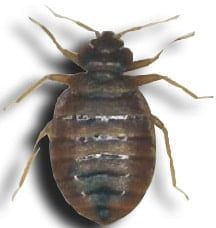 Identify: Swallow bugs are approximately the same color and size as a bed bug but are covered in longer hair.
Identify: Swallow bugs are approximately the same color and size as a bed bug but are covered in longer hair.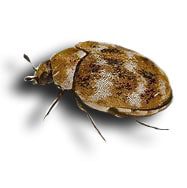 Identify: Carpet beetle adults can appear small and round like bed bugs, but they are actually smaller (no larger than 1/7 of an inch) and vary in color—some are patterned with black, white and yellow. Another important difference is carpet beetles have wings and can fly, while bed bugs cannot.
Identify: Carpet beetle adults can appear small and round like bed bugs, but they are actually smaller (no larger than 1/7 of an inch) and vary in color—some are patterned with black, white and yellow. Another important difference is carpet beetles have wings and can fly, while bed bugs cannot.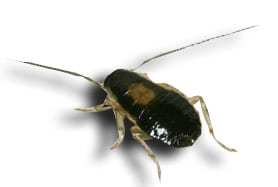 Identify: Cockroach nymphs are white upon hatching, but quickly turn a reddish-brown similar to bed bugs. They have more of a cylinder shape than bed bugs.
Identify: Cockroach nymphs are white upon hatching, but quickly turn a reddish-brown similar to bed bugs. They have more of a cylinder shape than bed bugs.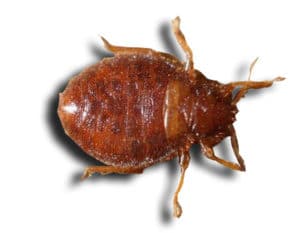 Identify: Bat bugs are blood-sucking insects that feed mostly on bats hence the name. Bat bugs are closely related to bed bugs, and are so similar in appearance that they are often mistaken for bed bugs. Microscopic examination is needed to distinguish them.
Identify: Bat bugs are blood-sucking insects that feed mostly on bats hence the name. Bat bugs are closely related to bed bugs, and are so similar in appearance that they are often mistaken for bed bugs. Microscopic examination is needed to distinguish them.
Leave A Comment